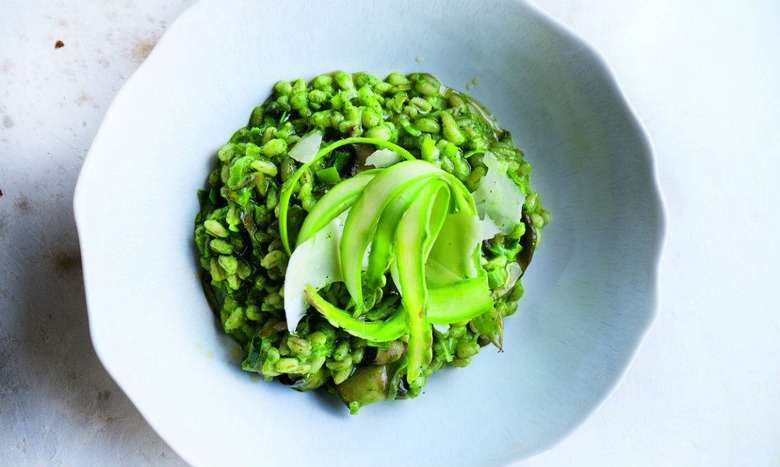Pearl Barley Risotto With Watercress, Asparagus, And Pecorino
Pearl Barley Risotto With Watercress, Asparagus, And Pecorino
We know that the use of the word risotto here should be in big quotation marks. People get very protective about the rules of their culinary heritage. Yotam’s opinion about what is and what isn’t allowed to go into the making of hummus, for example, is as unwavering as an Italian chef’s rules for the ingredients list in a risotto. Disclaimers aside, making risotto with pearl barley adds bite and texture that work very well with the smooth, green watercress puree.Start with thick-stemmed asparagus for this, if you can: it’ll make it far easier to shave each spear with a vegetable peeler and get the ribbons you’re after. Don’t be put off from making this if asparagus is not in season, thin ribbons of zucchini — shaved raw with a vegetable peeler — work well as an alternative. One medium zucchini will be enough to produce about 6 ½ ounces/180 g of shaved ribbons.Reprinted with permission from NOPI by Yotam Ottolenghi and Ramael Scully, copyright © 2015. Published by Ten Speed Press, an imprint of Penguin Random House LLC.

Ingredients
- 1 1/2 cup pearl barley
- 10 cup vegetable stock
- 3 1/2 ounce baby spinach leaves
- 7 ounce watercress
- 6 tablespoon olive oil
- 1/2 cup unsalted butter (two-thirds cut into a third of an inch dice, one-third in one piece)
- 1 medium shallot, finely diced
- 2 cloves garlic, finely chopped
- 3 thyme sprigs
- 1 bay leaf
- 4 portobello mushrooms, stalks and caps thinly sliced
- 1 medium leek, green and white parts thinly sliced
- 2 tablespoon lemon juice
- coarse sea salt and black pepper, to taste
Directions
- Place the barley in a medium saucepan and pour over 7 cups of stock. Bring to a boil over high heat, then reduce the heat to medium and simmer for 30 to 35 minutes, uncovered, until cooked but still retaining a bite. Strain and set aside.
- Wash out the saucepan and fill it with water. Bring to a boil, add the spinach, and blanch for 30 seconds, then use a slotted spoon to transfer the leaves to a colander. Rinse well under cold water — this will help prevent discoloration — then squeeze out the excess moisture and set aside. Keeping the pan of water on the boil, add the watercress and blanch for 30 seconds. Transfer to a colander, rinse under cold water, and squeeze out the excess moisture. Add to the spinach leaves, coarsely chop, and set aside.
- Wipe out the saucepan and add 2 tablespoons of olive oil, along with the undiced butter. Place over medium heat, add the shallots and garlic, and cook for 6 to 7 minutes, stirring often, until soft but taking on no color. Add the thyme and bay leaf, pour over 2 cups of stock and bring to a boil over high heat. Cook for 10 minutes, for the stock to reduce down to a quarter, so that you have about 3 1/2 tablespoons left in the pan. Add the spinach and watercress leaves and cook for a final 2 minutes. Remove from the heat, lift out and discard the bay leaf and thyme, then, while still hot, carefully transfer to a blender with 1/2 teaspoon of salt and a few cracks of black pepper. Turn on the blender and blitz, adding the diced butter a few cubes at a time, waiting until one batch has been incorporated before adding the next. Set aside.
- Put 2 tablespoons of oil in a large sauté pan and place over high heat. Add the mushrooms and cook for 3 minutes, until softened but not colored. Remove the mushrooms, along with any liquid in the pan, and set aside. Return the large sauté pan to medium-high heat with the remaining 2 tablespoons of oil. Add the leek and cook for 3 minutes, until softened but having taken on no color. Leave in the pan and set aside.